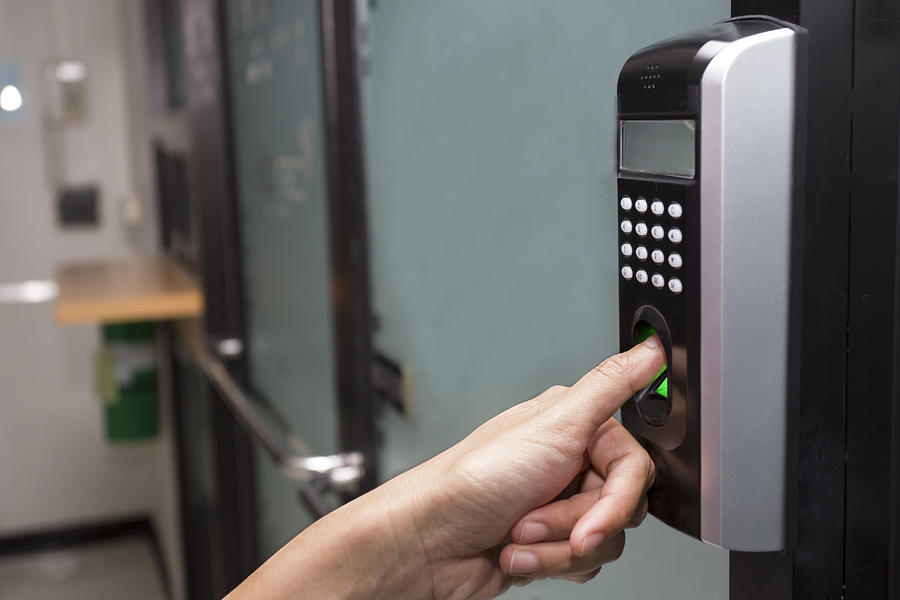A biometric recognition timeclock is a great way to assure that the employee who is ‘on the clock’ is actually the one on-site and performing work, as it utilizes a part of the person’s body as their verification. In mainstream practice, I find two main types of biometric clocks; hand recognition and fingerprint recognition. In this article, I will discuss a few pros and cons, and how reliable they are in making a positive id.
First up is hand recognition. The device is the HandPunch clock which reads the unique geometry of each person’s hand. Contrary to popular belief, it does not read the person’s palm or finger prints, but it simply measures the length, width, and height of each of the four fingers of right hand. Fairly simple technology when you think about it. In fact, an individual missing a finger or even their entire right hand, can actually use their left hand upside down and successfully be registered on the clock and subsequently punch in/out. This is a good device as it is not sensitive to dirty hands, but it is highly susceptible to a dirty environment as the device uses a camera to view the hand. If dirt and debris gets in the way of the camera’s view, then its ability to take the measurement may fail. I would also consider it somewhat easy to spoof. Not something that can be done on a whim, but with a little planning and a day’s notice it is possible. All you need is a representation of the user’s hand, and a search of “silicon mold of hand” will put you on track to making one.
Now, on to fingerprints. Every finger has a unique print which is formed during the first trimester when we are in the womb. They can be made up of three distinct patterns containing arches, loops, and whorls, and it has been determined that general patterns are inherited, and you may share similarities to your parents. Unlike hand recognition, the fingerprint reading technology is almost as numerous as one has fingers, and I will ‘touch’ on a few of them.
Let’s break it down into two general types of technology. I would call one visual or optical, while the other we will call non-visual, to put it in layman’s terms. The visual utilizes a capture of a digital image looking at the surface of the finger. This type of clock is easy to recognize as the platen where finger is placed is a glass like surface and will most likely have a glow of light emitting from it. Underneath the surface is a prism where it is illuminated through one side and reflected through the opposite. A dirty surface can cause a bad image of the fingerprint, thus an unsuccessful verification. A huge disadvantage to this type of reader is the fact that the recognition is affected by the quality of the skin on the finger. A scared or dirty finger is easy to overcome by making sure the hands are clean and utilizing a finger that has a good quality print. The elasticity of skin also decreases with age, so we will find many seniors with prints that are either difficult to read, or non-existent. It is said that 1-2% of the population does not have fingerprints that will register on this type of technology. Another bad feature of the visual recognition reader is that they are even easier to spoof. Many readers can be fooled by a gelatin mold or even a photo copy (with a high relief) of a fingerprint. The show MythBusters did a segment on bypassing fingerprint readers with a number of methods and each were based on this type of reader.
Non-visual technology comes in a few flavors, ultrasound, solid-state, and multi-spectral. Ultrasound sensors employ acoustic signals transmitted towards the finger surface. Acoustic waves travel at different speeds through ridges and air lodged under the skin. The reflected acoustic signal or echo is captured to generate the image. This technology can be compromised by soft artificial materials such as gelatin (aka, the gummy bear spoof), and is not commonly found in use. A popular solid-state method is capacitive technology, which can also be found in the iPhone 6. This utilizes a system of electrical charges to measure the ridges and valleys of the sub-dermal live skin layer to form a fingerprint image. Sub-dermal is a plus, as they eliminate the need for clean, undamaged epidermal skin and a crystal clean reader surface. Multi-spectral imaging technology uses different light wavelengths to capture a sub-surface image. This type of system can differentiate between real fingers and simulated fingerprint ridges, as different wavelengths penetrate the skin to different depths and are absorbed differently by various chemical components of the skin. This technology is highly accurate, and can read fingerprints even when there is no visible print.
No matter which fingerprint device is decided upon, be sure that it does not store actual images of fingerprints, but rather what is referred to as a template. When a print is initially read during enrollment, it is translated to a numeric value, specific to the clock’s manufacturer. Then each time a print is obtained and converted to a template value, it is compared to the stored values. A match will prove a successful verification of identity. A system that stores actual images would be susceptible to identity theft. In fact, just last year, the Office of Personnel Management, which screens and hires federal workers, had a massive breach where 5.6 million fingerprint images were stolen. The ability to use this form of stolen identity is fairly limited right now, but could change over time as technology evolves.

